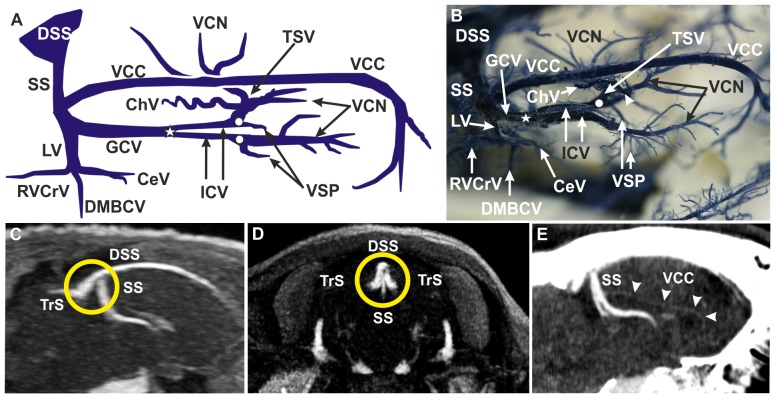Figure 2. Deep cerebral venous system.
(A) Schematic drawing of corrosion cast, lateral right view. The straight sinus (SS) was the venous drainage route of the medial cortex, the corpus callosum, the basal ganglia and part of the diencephalon (A–E). (B) Corrosion cast, dorsolateral right view. The unpaired great cerebral vein (GCV) was formed by both internal cerebral veins (ICV) in the ‘confluens venosus caudalis’ (A, B; white star). The vein of corpus callosum (VCC) and the lateral vein (LV), with three tributaries, drained into the GCV. The ICVs originated from two distinct converging branches in the ‘confluens venosus rostralis’ (A, B; white dots): the vein of the septum pellucidum (VSP) and the thalamostriate vein (TSV). The TSVs received inflow from caudate nucleus veins (VCN; A, B) and from the choroidal vein (ChV; A, B). (C) MRV, sagittal section. (D) MRV, coronal section. The confluence of sinuses (orange circle; C, D) referred to the crossroad between the DSS, the SS and both transverse sinuses (TrS). (E) CTV, sagittal section. The VCC was large and conspicuous in the corrosion cast (A, B), but much less prominent in CTV imaging (E, arrowheads). CeV: central vein, ChV: choroidal vein, DMBCV: dorsomedial basilar cerebral vein, DSS: dorsal sagittal sinus, GCV: great cerebral vein, ICV: internal cerebral vein, LV: lateral vein, RVCrV: rostral ventral cerebellar vein, SS: straight sinus, TrS: transverse sinus, TSV: thalamostriate vein, VCC: vein of the corpus callosum, VCN: vein of caudate nucleus, VSP: vein of the septum pellucidum. Please note: right TSV removed for better insight and interpretation in A and B.

